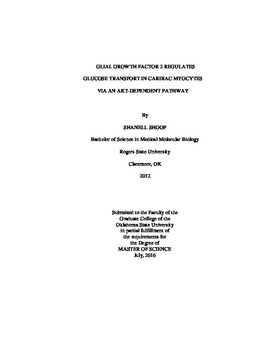| dc.description.abstract | Neuregulin, a paracrine factor in myocytes, promotes cardiac development via the ErbB receptors. Neuregulin-1β also improves cardiac function and cell survival after myocardial infarction, although the molecular mechanisms underlying these cardio-protective effects are not well elucidated. Increased glucose uptake has been shown to be cardio-protective during myocardial infarction. Therefore, we hypothesized that acute treatment with neuregulin-1β3 isoform, glial growth factor 2 (GGF2; USAN - cimaglermin alfa), will enhance glucose transport in the myocardium through insulin and calcium-dependent pathways. Isolated cardiac myocytes from healthy adult rats were incubated for 1 hour with and without Afatinib, an ErbB 2/4 receptor blocker, and/or GGF2 for an additional hour (n=4-15/group). Glucose uptake was measured using a fluorescent D-glucose analog. The translocation of the glucose transporter (GLUT) 4 to the cell surface, the rate-limiting step in glucose uptake, was measured using a photolabeled biotinylation assay. Expression and phosphorylation of key proteins of the downstream insulin signaling pathway were measured by Western blotting. Similar to insulin, acute GGF2 treatment increased glucose uptake in healthy myocytes (by 49%, P<0.05). GGF2 and calcium also increased GLUT4 translocation in myocytes by 117% (P<0.02) and 511% (P<0.001), respectively; while ErbB 2/4 blockage blunted these effects. GGF2 also enhanced Akt phosphorylation (at both threonine and serine sites, by 75% and 139%, respectively, P<0.05), which was blunted by ErbB 2/4 blockage. In addition, GGF2 treatment increased the phosphorylation of AS160 (an Akt effector) by 72% (P<0.05), as well as the phosphorylation of PDK-1 and PKC (by 206% and 100%, respectively, P<0.05). In conclusion, our data demonstrate that acute GGF2 treatment increases GLUT4 translocation and thus glucose uptake, in cardiac myocytes by activating the ErbB 2/4 receptors and subsequently key insulin downstream effectors (i.e., PDK1, Akt, AS160 and PKC). Similarly, calcium-activated GLUT4 translocation is mediated by ErbB 2/4 receptor activation. These findings highlighted some novel mechanisms of action of GGF2, which warrant further investigation in patients with heart failure. | |
